"PARIS IN THE SPRING"
Sure — it's Spring again — a nice one at that — and
the lights are on once more in Paris.
We did our share of planning and working and sweating to help
rekindle those lights — and we may well feel proud of the job we've done.
This booklet is dedicated to the men who helped complete that
job. To the men who drove the trucks and carried the litters, repaired facilities
and kept the supplies rolling forward; to the men who — ever willing —
did a job of which they may well feel proud... This booklet, in other words, is
dedicated to "YOU"!!
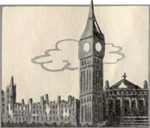 BACKGROUND
BACKGROUND
The personnel of Seine Section were on duty
first in London, England, assigned to Central Base Section, under
the command of Brigadier General Pleas B. Rogers with headquarters
on Regent Street. The boundaries of CBS incorporated
metropolitan London.
The mission assigned Central Base Section was to provide all
of the supplies and services for all American Army units in London which
included USAFBI (U. S. Army Forces in the British Isles), ETOUSA (European
Theater of Operations U. S. Army), Hq., Allied Force (for North Africa), Hq.
SOS (Services of Supply), and Hq., 1st Army Group (later 12th A. G.). In
addition London was a leave center for 1,500 officers and 15,000 enlisted men,
total strength served, approximately 33,000.
PLANNING PERIOD
A plan was prepared for the organization of Seine Section and
submitted to Com Z (Communications Zone) on 31 July 1944. Fighting broke out in
Paris between the Resistance and the Germans 19 August 1944. On 21 August,
in response to a military cable from Com Z, Forward, General Rogers flew to
Valognes, France, and started a small planning group forward from Central Base
Section by motor, and LCT (Landing Craft Tank), to complete the plan for the
organization of Seine Section. The plan submitted 31 July was approved 22 August
and by the 24th of that month it was evident that Paris would soon fall. NOW
STARTS THE ACTION!!
WE MOVE TO PARIS
General Rogers was already in Valognes, conferring with the General
and Special Staff Sections of Headquarters, Com Z, (Forward). Advance Detachment
Number One composed of 11 officers, mostly section chiefs, and 14 enlisted
men left London 22 August by motor for Southampton and from there by LCT
for France arriving at Utah Beach (remember that hill we climbed??) at 1200 hours
of the 24th. Advance Detachment Number Two composed of 32 officers and
105 enlisted men left London by plane the 24th of August and arrived in Cherbourg
a little over an hour after the take-off. On the 24th of August General
Rogers flew to Bayeux and conferred with his new British Deputy, Brigadier
M. A. Carthew-Yorstoun, DSO, MBE, thence to Chartres and conferred with
General Omar Bradley, Commanding General 12th Army Group in regards to
taking over the Paris area as soon as possible, while it was in the combat zone,
thence on the 25th to Le Mans where he joined his advance party.

After conferring with Headquarters "ADSEC" (Advance Section,
Communications Zone) in Le Mans, General Rogers led the convoy into
"Gay Paree" on the day of Liberation, 25 August 1944!
CONDITIONS IN PARIS
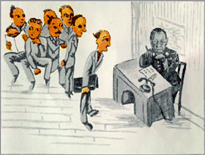 Paris had fallen very suddenly and
the proper agencies were unable to cope with
the situation. People thought that we had
an inexhaustible supply of food and lots of
clothing, yes, and plenty of gasoline for their cars. Our G-4 and G-5 offices
were as crowded as a Paris metro. One American resident demanded the daily
delivery of specified brand foods to his house for the personal use of his family
and maid! In fact, we had so little that we had to send four trucks (we had
14 in all) back to Cherbourg for K, C and 10 in 1 food rations to feed our men.
The German depots contained great quantities of all types of supplies, but
stocks had to be surveyed and distribution handled judiciously and not scattered
hither and yon as expected.
Paris had fallen very suddenly and
the proper agencies were unable to cope with
the situation. People thought that we had
an inexhaustible supply of food and lots of
clothing, yes, and plenty of gasoline for their cars. Our G-4 and G-5 offices
were as crowded as a Paris metro. One American resident demanded the daily
delivery of specified brand foods to his house for the personal use of his family
and maid! In fact, we had so little that we had to send four trucks (we had
14 in all) back to Cherbourg for K, C and 10 in 1 food rations to feed our men.
The German depots contained great quantities of all types of supplies, but
stocks had to be surveyed and distribution handled judiciously and not scattered
hither and yon as expected.
The Military Police did an outstanding job of guarding the depots,
saving valuable stocks of captured enemy material.
HIGHLIGHTS
Beginning in September 1944, one of the large and important systems
of supply depots on the Continent was organized in Seine Section to serve the
frontline troops. These depots received more than 1,150,000 tons of supplies
and shipped out more than 1,000,000 tons prior to VE-Day. Included in
the outbound shipments were 150,000 tons of captured enemy material, most
of which was forwarded to our fighting forces during the early winter months.
With the liberation of the population, the wants were many and
the supplies very inadequate. No trains or barges were operating due to the
bombing and sabotage of rail and water lines during the German occupation.
Automobiles had not been allowed to operate by the Germans. The metro
lines could not operate because of lack of power. Transportation was limited to
cycling and walking. Gasoline was so precious for the first two weeks
that no issue could be made until our G-4 had personally examined and
approved each and every request. It is literally impossible to recount in detail
how the personnel and units of Seine Section met these difficulties. The task
was immense, the problems manifold, and the difficulties at times seemed
insurmountable. But the courage and initiative of the officers and men of this section
were equal to the demands made upon them.
WHAT DID WE DO??
Well, just for the record — and for our wives and kids back home —
and for the fighting men whom we kept supplied — here's what we did...
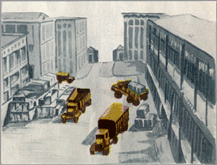 We supported the armies with most of
their Class I Quartermaster supplies for the period
23 October to 28 November 1944, shipping a maximum
of six trains per day; made available all the gasoline
from the pipeline for the period 1 October 1944 to 15 March 1945, or a total of
one and a half million gallons per day; furnished all the engineer material required
by our armies for the period September to December 1944, using supplies which
had been left behind by the Germans when they evacuated from Paris. We
operated 14 million square feet of storage space, which was 10% of that on the
Continent. The transportation facilities from 27 August 1944 to V-E plus 7 brought
814,264 personnel into Paris, shipped out 821,930 and handled 1,364,737 more in
transit... a total of 3,000,931 troops transported by Seine Section.
We supported the armies with most of
their Class I Quartermaster supplies for the period
23 October to 28 November 1944, shipping a maximum
of six trains per day; made available all the gasoline
from the pipeline for the period 1 October 1944 to 15 March 1945, or a total of
one and a half million gallons per day; furnished all the engineer material required
by our armies for the period September to December 1944, using supplies which
had been left behind by the Germans when they evacuated from Paris. We
operated 14 million square feet of storage space, which was 10% of that on the
Continent. The transportation facilities from 27 August 1944 to V-E plus 7 brought
814,264 personnel into Paris, shipped out 821,930 and handled 1,364,737 more in
transit... a total of 3,000,931 troops transported by Seine Section.
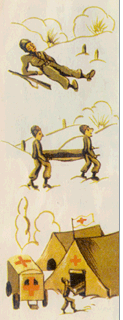 We requisitioned over 3,600 pieces of property for office space,
billets and depots; hired approximately 110,000 civilians, cleared 90 miles of the
Oise Canal, including the repair and construction of locks and bridges,
the removal of 34 demolished bridges and the construction of two new
bridges across the Seine River. We operated 11 General and 5 Station
Hospitals filled to from 150% to 200% of capacity during peak operations,
as well as 42 hospital trains. We handled over a half million patients
in our General Hospitals and evacuated almost a hundred thousand patients
by air to the United Kingdom and 12,000 to the U. S. A. Complete laboratory
facilities and specialized treatment centers for neuro-surgery, plastic
surgery, chest surgery, etc., were established for the latest specialized
treatment of casualties evacuated from other areas.
We requisitioned over 3,600 pieces of property for office space,
billets and depots; hired approximately 110,000 civilians, cleared 90 miles of the
Oise Canal, including the repair and construction of locks and bridges,
the removal of 34 demolished bridges and the construction of two new
bridges across the Seine River. We operated 11 General and 5 Station
Hospitals filled to from 150% to 200% of capacity during peak operations,
as well as 42 hospital trains. We handled over a half million patients
in our General Hospitals and evacuated almost a hundred thousand patients
by air to the United Kingdom and 12,000 to the U. S. A. Complete laboratory
facilities and specialized treatment centers for neuro-surgery, plastic
surgery, chest surgery, etc., were established for the latest specialized
treatment of casualties evacuated from other areas.

Our Signal Corps Spare Parts and Base Maintenance Depot,
at S-891, was the only shop of its kind on the Continent, and in addition
to storing and distributing spare parts to all the Army Ground Forces,
this Depot also repaired all types of Signal Corps equipment. Ordnance
Depot number 0-644 was the largest base, filler, and issue depot on the Continent
for all groups of class II and IV Ordnance material, handling 1,204 long tons
daily. From the latter part of November and during the month of December 1944,
Quartermaster Depot number Q-177 was operating under the control of Seine
Section, and handled an average tonnage of 5,800 tons daily of Class I
supplies.
Our Post Exchange Distributing Point served the 50,000 troops
assigned to Seine Section plus 400,000 troops operating in other continental
locations but authorized to draw PX supplies from the Paris DP since it
was the closest supply point. A high priority was placed by the Army
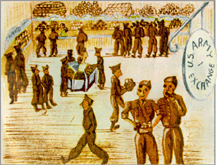 Exchange Service upon serving the needs of battle
casualties in Seine Section hospitals. Gratuitous
rations were issued to hospitalized battle
casualties who were without funds, and who had
not received comparable issues from other
authorized agencies. A unique service was provided
for casualties who were being evacuated to
the Zone of the Interior. This involved the procurement, through local sources,
of special gift items such as perfumes, novelty jewelry and ladies accessories
which, as they were difficult to procure, were reserved for issue to Hospital
Exchanges for exclusive sale to such patients. This service was also
available to combat troops on 3-day pass from the fighting fronts. This service
was considered to be of especial morale significance in that this was the
final, and, in many cases, the only, opportunity for the purchase of such
gifts while in the Paris area.
Exchange Service upon serving the needs of battle
casualties in Seine Section hospitals. Gratuitous
rations were issued to hospitalized battle
casualties who were without funds, and who had
not received comparable issues from other
authorized agencies. A unique service was provided
for casualties who were being evacuated to
the Zone of the Interior. This involved the procurement, through local sources,
of special gift items such as perfumes, novelty jewelry and ladies accessories
which, as they were difficult to procure, were reserved for issue to Hospital
Exchanges for exclusive sale to such patients. This service was also
available to combat troops on 3-day pass from the fighting fronts. This service
was considered to be of especial morale significance in that this was the
final, and, in many cases, the only, opportunity for the purchase of such
gifts while in the Paris area.
On 16 December 1944 came word of the German counter-attack
into Luxembourg which immediately threatened communications zone
installations in forward areas. The 3619th Quartermaster Trucking Company was
given the mission of moving a portion of the 101st Airborne Division to
Bastogne on 19 December 1944. This Company was expected to return to
Paris the following day but because of the situation it was not possible
to release the trucks as planned, and it became necessary for the officer
and the enlisted men of this company to become a part of the combat
element of an airborne battalion, although they were not familiar with
combat conditions. These men were later cited for the rapidity with which they adapted
themselves and for the assistance they gave the battalion during the battle of
the bulge. Word was received through Counter-Intelligence Agencies that German
agents, in conjunction with the breakthrough, were to be infiltrated by various
means into Paris, with the primary mission of sabotage. At that time, we were
alerted 24 hours daily and a curfew was put into effect. The Counter-Intelligence
Branch of the G-2 Section immediately went into action to meet the enemy threat,
and elaborate security precautions were undertaken. Guards were doubled
on all installations and four Engineer Combat Battalions were assigned to
our section for the protection of vital installations, namely railway bridges,
POL installations, etc... Road-blocks were established at all entrances to
the city of Paris
and all cars
were stopped
and occupants
questioned.
Suspicious
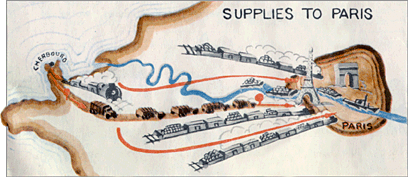 characters were taken
into custody and
brought to our G-2
Section where
over seven hundred of these suspects were "screened". As a result of
these efforts, eight enemy saboteurs and four enemy parachutists who had
landed at Souppes (Seine et Marne), along with many "smaller fry" operators
were caught and Seine Section efforts contributed to the complete thwarting
of the attempt by Nazi agents to disrupt our lines of communications.
characters were taken
into custody and
brought to our G-2
Section where
over seven hundred of these suspects were "screened". As a result of
these efforts, eight enemy saboteurs and four enemy parachutists who had
landed at Souppes (Seine et Marne), along with many "smaller fry" operators
were caught and Seine Section efforts contributed to the complete thwarting
of the attempt by Nazi agents to disrupt our lines of communications.
Upon our arrival in Paris in August 1944 the distribution system for
food and other civilian essentials had temporarily broken down and many critically
needed items were totally unavailable from French sources. Over the period
of the next ten months quantities of equipment and supplies of all kinds were
delivered to the French civil authorities through G-5 channels. These supplies
comprised both AEF (Allied Expeditionary Forces) and captured enemy products. The
G-5 Monuments Officer insured the preservation of monuments, works of
art and archives and, consistent with military
necessity, placed out-of-bounds many private chateaux
because of their historical value and because they
contained works of art and furnishings
impossible to replace.
During the same period of time the
Civil Affairs organization aided in the supply, maintenance, transportation
and repatriation of thousands of displaced persons representing almost a
cross section of the world's nationalities.
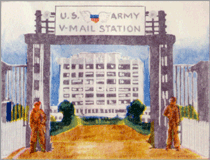 All V-Mail operations on the Continent were under our 23rd
Base Post Office located at Villepinte. Between 1 February and 30 April 1945
over thirty million letters were dispatched on film rolls. The receiving section
processed 32,194,081 inbound V-Letters in a ten day period commencing
18 February 1945.
All V-Mail operations on the Continent were under our 23rd
Base Post Office located at Villepinte. Between 1 February and 30 April 1945
over thirty million letters were dispatched on film rolls. The receiving section
processed 32,194,081 inbound V-Letters in a ten day period commencing
18 February 1945.
The establishment of Paris as an important leave center brought
with it the need for lodging, messing and recreational facilities for the
U. S. Forces. The American Red Cross made available a number of clubs
for all branches of the service. The first club to open in Paris was
Rainbow Corner, which opened on 3 September 1944. By V-E Day, 8 May
1945, there were fourteen clubs open in Paris plus three day-clubs for
feeding. By the middle of June 1945, there were a total of approximately
10,000 beds for leave troops. Over a hundred thousand officers and men
per week attended six of our large Cinemas and Theaters.
FINALE
At last came the day that none of us will forget — V-E
Day — 8 May 1945!!
The cessation of hostilities in this theater did not mean that
our operations would also cease, though rumors of every imaginable
description were heard from all sides. Most of us paid little attention to these
rumors because even if we had finished the greater part of a tough assignment,
a good man doesn't want to leave a job unfinished.
The job that has been completed has been finished in a superior
manner. It has been a source of pride to your Commanding General and
you may feel proud that you did your share in bringing the Nazis to their
knees. Your efforts have produced positive results and in every way have
been a credit to the Army of the United States.

PLEAS B. ROGERS
Brigadier General, U. S. Army,
Commanding
ASSIGNMENTS
TO
HEADQUARTERS STAFF
BRIGADIER
GENERAL PLEAS B. ROGERS, Commanding
GENERAL STAFF |
| |
| Chief of Staff | ..... | Col EUGENE J. BLAKELY, Jr, GSC |
..... | Lexington, Va. |
| Acting Chief of Staff | ..... | Lt Col JULIAN D. ABELL, CE |
..... | Nappanee, Ind. |
| Deputy Chief of Staff | ..... | Lt Col FRANCIS L. REMUS, GSC |
..... | Minneapolis, Minn. |
| Secretary of the General Staff | ..... | 1st Lt HARRY F. BEAR, MAC |
..... | Baltimore, Md. |
| | Capt ROSE F. ROSS, WAC |
..... | Long Island, N. Y. |
| | Capt DONALD E. WENTZEL, AC |
| |
| A C of S, G-1 | ..... | Col PAUL K. BROWN, GSC |
..... | Norristown, Pa. |
| A C of S, G-2 & G-3 | ..... | Col HENRY C. AHALT, GSC |
..... | Blacksburg, Va. |
| A C of S, G-4 | ..... | Col LOREN W POTTER, GSC |
..... | Laclede, Mo. |
| A C of S, G-5 | ..... | Col ROBERT P. HAMILTON, GSC |
..... | Columbia University, N. Y., N. Y. |
| General Purchasing Agent | ..... | Col LEELAN E. WITNEY, GSC |
..... | Peabody, Mass. |
| |
SPECIAL STAFF |
| |
| Adjutant General | ..... |
Lt Col RAY C. SCOTT, AGD | ..... |
Sacramento, Cal. |
| ..... |
Lt Col DAVID C. MAYERS, AGD | ..... |
San Francisco, Cal. |
| Army Exchange Officer | ..... |
Major KAUFMAN R. KATZ, QMC | ..... |
Baltimore, Md. |
| Chaplain | ..... |
Chap (Maj) CHESTER R. MC CLELLAND | ..... |
Dallas, Texas. |
| Chemical Warfare Officer | ..... |
Lt Col HENRY G. BEAMER, CWS | ..... |
East Pittsburgh, Pa. |
| ..... |
Maj KENNETH E. KITCHEN, CWS | |
|
| Chief, Control, Control Division | ..... |
Cap ARTHUR E. NEIGLER, FA | ..... |
Brooklyn, N. Y. |
| |
Maj HOWARD E. SOMMER, QMC | ..... |
Chicago, Ill. |
| |
Lt Col HARRY H. STOUT, Jr, ORD | |
|
| Director, Claims Service | ..... |
Lt Col ALDO H. LOOS, JAGD | ..... |
Kansas City, Mo. |
| |
Col DAVID C. BYRD, JAGD | ..... |
Atlanta, Ga. |
| Engineer Officer | ..... |
Col ROBERT E. M. DES ISLETS, CE | ..... |
Kansas City, Mo. |
| |
Col PHILIP R. GARGES, CE | ..... |
Washington, D. C. |
| |
Col ALBERT RIANI, CE | |
|
| |
Lt Col JAMES R. GRIFFITH, Jr, CE | |
|
| Fiscal Officer | ..... |
Capt ROBERT J. FARRIS, FD | ..... |
Tulsa, Okla. |
| |
Lt Col CLARENCE C. NEELY, FD | | |
| French Liaison Officer | ..... |
Maj ROLAND DE MAILLE, French Army | ..... |
Paris, France |
| Headquarters Commandant | ..... |
Lt Col JAMES B. RAMAGE, Inf | ..... |
Atlanta, Ga. |
| |
Maj JOSEPH W. SAUNDERS, Inf | ..... |
Silver Spring, Md. |
| Historian | ..... |
1st Lt HARRY F. BEAR, MAC | ..... |
Baltimore, Md. |
| Information and Education | ..... |
Capt FRANCIS M. DOWD, AUS | ..... |
East Orange, N. J. |
| Inspector General | ..... |
Maj WILLIAM J. ENGERT, IGD | ..... |
Knoxville, Tenn. |
| |
Col FRED S. HANNA, IGD | ..... |
Columbia, Mo. |
| Mess Director | ..... |
Maj WALTER A. STANSBURY, QMC | ..... |
Goldsboro, N. C. |
| Miscellaneous Supply | ..... |
Lt Col WILLIAM E. WILLEY, QMC | ..... |
Salt Lake City, Utah |
| Ordnance Officer | ..... |
Col FLOYD C. DEVINBECK, Ord | ..... |
Washington D. C. |
| |
Col JOSEPH HORRIDGE, Ord | ..... |
Chambersburg, Pa. |
| |
Lt Col FRED Q. AUNGST, Ord | ..... |
Palmyra, Pa. |
| |
Capt ALBERT RISI, Ord | ..... |
Bridgeport, Conn. |
| Postal Officer | ..... |
Lt Col EARL A. BARNHART, AGD | ..... |
Dana, Ill. |
| |
Maj FRANCIS P. KAINE, AGD | ..... |
South Plainfield, N. J. |
| |
Maj ERVIN W. BOETTCHER, AGD | ..... |
Chicago, Ill. |
| |
Capt CECIL E. MASON, AGD | |
|
| Provost Marshal | ..... |
Col ERNEST G. BUHRMASTER, CMP | ..... |
Scotia, N. Y. |
| Public Relations Officer | ..... |
Capt DAVID G. WYLIE, CE | ..... |
Chicago, Ill. |
| |
2nd Lt HUBERT C. BUTTS, CWS | | |
| Quartermaster | ..... |
Col FLOYD C. HARDING, QMC | ..... |
Falls City, Neb. |
| |
Col WILBERT V. RENNER, QMC | | |
| |
Col CHARLES A. VALVERDE, QMC | | |
| Signal Officer | ..... |
Col WALTER J. ROSENGREN, SC | ..... |
N. Y., N. Y. |
| Special Service | ..... |
Lt Col RALPH W. RUFFNER, Inf | ..... |
Washington, D. C. |
| |
Maj WARD J. WALKER, Inf | | |
| Special Troops | ..... |
Lt Col JULIAN D. ABELL, CE | ..... |
Nappanee, Ind. |
| |
Maj JOSEPH W. SAUNDERS, Inf | ..... |
Silver Spring, Md. |
| Staff Judge Advocate | ..... |
Col CLARENCE E. BRAND, JAGD | ..... |
Washington D. C. |
| |
Lt Col VINCENT A. MILLER, JAGD | | |
| Surgeon | ..... |
Col THAIR C. RICH, MC | ..... |
Odgen, Utah. |
| Transportation Officer | ..... |
Col HERBERT P. EVANS, TC | ..... |
Scituate, Mass. |
| Versailles District | ..... |
Lt Col CHARLES A. MERKLE, Inf | ..... |
Los Angeles, Calif. |
| |
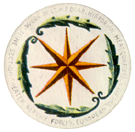
Work by Lt. H. F. Bear
Historian, Headquarters, Seine Section
Theater Service Forces, European Theater
660th ENGR BASE TOPO BN, ETO
|
![[Lone Sentry: Seine Section, Paris, France, 1945]](../../pics/sentrysmall.jpg)
![[Lone Sentry: Photos, Articles, and Research on WWII]](../../pics/lonesentrylogo.jpg)